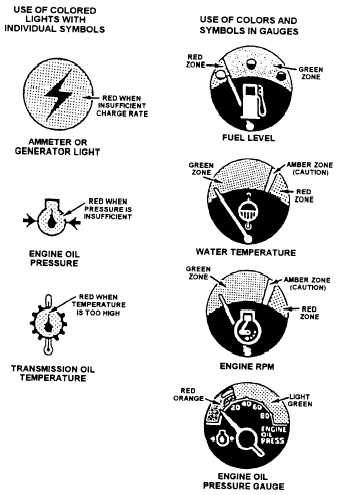electrical system, is provided with a fuse that has an
ampere rating for the maximum current required to
operate the unit.
The fuse element is made from a metal that has a
low-melting point and is the weakest point in the
electrical circuit. In case of a short circuit or other
trouble, the fuse burns out first and this opens the circuit
just as a switch would do. Visual examination of a
burned-out fuse usually provides a quick indication of
the problem. A discolored sight glass indicates the
circuit has a short either in the wiring or one of its
components. If the glass is clear, the problem may be
an overload in the circuit.
When replacing a fuse, you should ensure that it has
a rating equal to the one burned out. Also, ensure that
the malfunction that caused the failure has been
determined and repaired.
GAUGES
Just because everything checks out okay during the
prestart operation does not mean it will stay that way
throughout the workday. You must continually monitor
certain conditions, such as water temperature, oil
pressure, and so forth, to ensure the equipment is
running correctly. You monitor them by watching the
indicator (warning lights or gauges) on your equipment.
On equipment, you may see an analog type of gauge (fig.
4-7) or color-coded indicators, as shown in figure 4-8.
Figure 4-7.—Analog gauges.
Figure 4-8.-Color-coded gauges.
Water Temperature Gauge
When operating a piece of equipment, you must
monitor the water or coolant temperature gauge. If your
machine has an analog type of gauge (fig. 4-7), you must
know the correct operating temperature. Refer to the
operator’s manual to determine the operating
temperature. Anytime the temperature reading on the
gauge starts to rise, stop and determine the reason. Do
not wait until the gauge is in the red zone to investigate.
WARNING
Use extreme caution when removing a hot
radiator cap. Steam coming from the radiator
will cause severe burns.
4 - 6



